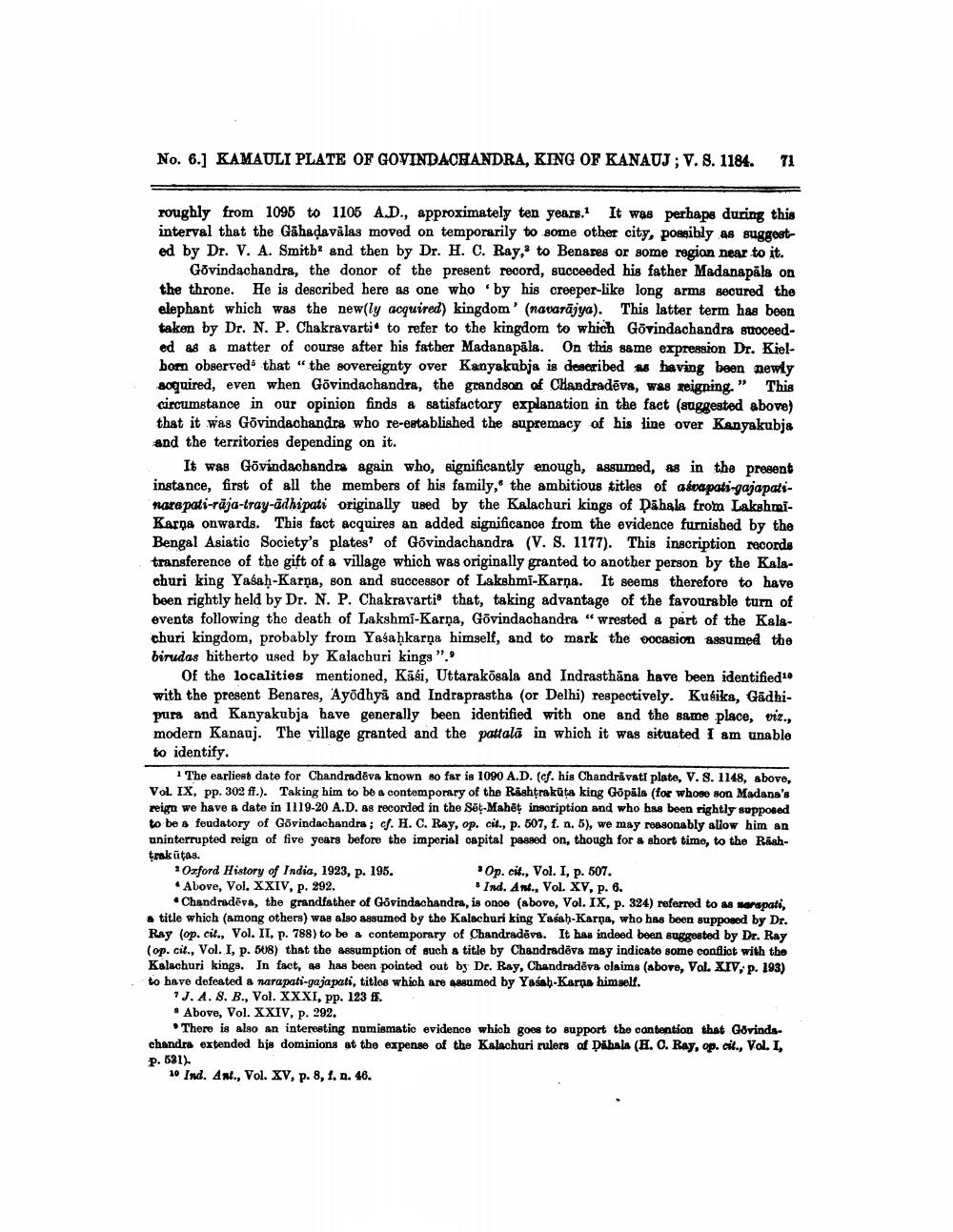________________
No. 6.] KAMAULI PLATE OF GOVINDACHANDRA, KING OF KANAUJ; V. 8. 1184. 71
roughly from 1095 to 1105 A.D., approximately ten years. It was perhaps during this interval that the Gahaḍavalas moved on temporarily to some other city, possibly as suggested by Dr. V. A. Smith and then by Dr. H. C. Ray, to Benares or some region near to it.
Govindachandra, the donor of the present record, succeeded his father Madanapala on the throne. He is described here as one who by his creeper-like long arms secured the elephant which was the newly acquired) kingdom' (navarajya). This latter term has been taken by Dr. N. P. Chakravarti to refer to the kingdom to which Govindachandra suoceeded as a matter of course after his father Madanapala. On this same expression Dr. Kielhorn observed that "the sovereignty over Kanyakubja is described as having been newly acquired, even when Govindachandra, the grandson of Chandradeva, was reigning." This circumstance in our opinion finds a satisfactory explanation in the fact (suggested above) that it was Govindachandra who re-established the supremacy of his line over Kanyakubja and the territories depending on it.
It was Govindachandra again who, significantly enough, assumed, as in the present instance, first of all the members of his family, the ambitious titles of asvapati-gajapatinarapati-raja-tray-adhipati originally used by the Kalachuri kings of Dahala from LakshmiKarga onwards. This fact acquires an added significance from the evidence furnished by the Bengal Asiatic Society's plates of Govindachandra (V. S. 1177). This inscription records transference of the gift of a village which was originally granted to another person by the Kalachuri king Yaśaḥ-Karna, son and successor of Lakshmi-Karna. It seems therefore to have been rightly held by Dr. N. P. Chakravartis that, taking advantage of the favourable turn of events following the death of Lakshmi-Karna, Govindachandra "wrested a part of the Kalachuri kingdom, probably from Yaśaḥkarna himself, and to mark the occasion assumed the birudas hitherto used by Kalachuri kings".
Of the localities mentioned, Käsi, Uttarakōsala and Indrasthana have been identified10 with the present Benares, Ayodhya and Indraprastha (or Delhi) respectively. Kušika, Gādhipura and Kanyakubja have generally been identified with one and the same place, viz., modern Kanauj. The village granted and the pattala in which it was situated I am unable to identify.
1 The earliest date for Chandradeva known so far is 1090 A.D. (cf. his Chandravati plate, V. S. 1148, above, Vol. IX, pp. 302 ff.). Taking him to be a contemporary of the Rashtrakuta king Gopala (for whose son Madana's reign we have a date in 1119-20 A.D. as recorded in the Set-Mahet inscription and who has been rightly supposed to be a feudatory of Govindachandra; cf. H. C. Ray, op. cit., p. 507, f. n. 5), we may reasonably allow him an uninterrupted reign of five years before the imperial capital passed on, though for a short time, to the Rashtrakūtas.
Op. cit., Vol. I, p. 507.
Ind. Ant., Vol. XV, p. 6.
Chandradeva, the grandfather of Govindachandra, is once (above, Vol. IX, p. 324) referred to as merapati, a title which (among others) was also assumed by the Kalachuri king Yasah-Karna, who has been supposed by Dr. Ray (op. cit., Vol. II, p. 788) to be a contemporary of Chandradeva. It has indeed been suggested by Dr. Ray (op. cit., Vol. I, p. 508) that the assumption of such a title by Chandradeva may indicate some conflict with the Kalachuri kings. In fact, as has been pointed out by Dr. Ray, Chandradeva claims (above, Vol. XIV, p. 193) to have defeated a narapati-gajapati, titles which are assumed by Yasah-Karna himself.
'J. A. 8. B., Vol. XXXI, pp. 123 ff.
Above, Vol. XXIV, p. 292.
There is also an interesting numismatic evidence which goes to support the contention that Govindachandra extended his dominions at the expense of the Kalachuri rulers of Dahala (H. C. Ray, op. cit., Vol. I, p. 531).
10 Ind. Ant., Vol. XV, p. 8, f. n. 46.
Oxford History of India, 1923, p. 195.
Above, Vol. XXIV, p. 292.




